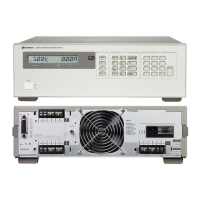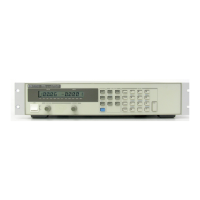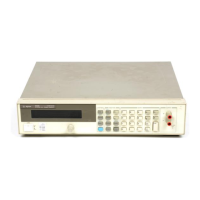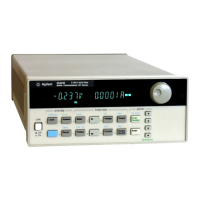2-24 OUTPUT BOARD
The following paragraphs provide block diagram level
descriptions of the output board. The descriptions cover the
two output board types. Differences between the board
types are given as required. Figure 2-1 shows which output
board types are used in the power supplies.
2-25 Secondary Interface Circuits (Figure 2-4)
These circuits receive digital signals from the GPIB board
and convert them to analog signals (voltages) which are sent
to the power mesh and control circuits to program the
output voltage, output current, and overvoltage.
Measurement and status signals are sent back to the
secondary interface circuits from the power mesh and
control circuits to be processed before they are sent on to the
GPIB board and then to the GPIB controller and/or the
front panel. The following paragraphs describe the interface
circuits shown in Figure 2-4.
2-26 Microcomputer. This 8-bit microcomputer (U312)
contains a CPU, ROM, and RAM. These internal circuits
process all data that is transferred between the GPIB board
and the power mesh and control circuits on the output
board. GPIB board data is transferred serially via optical
isolators which connect incoming data to an input port on
the microcomputer and outgoing data to an output port on
the microcomputer.
On the output board side, the microcomputer uses an 8-bit
parallel bi-directional data bus to program DACs which
control the output voltage, output current, overvoltage
setting, and sets the readback DAC. Various status and
operating conditions are read back on the data bus. The
microcomputer also generates address and control signals
which are used by other interface circuits. The interrupt
input to the microcomputer is used in conjunction with
readback monitor switches (U365, U366, and U368) analog
multiplexer (U323) and DAC (U321) to perform a successive
approximation A/D conversion in order to readback output
voltage and current values as well as various test point
voltages.
2-27 Address Decoder. This circuit (U320) decodes
addresses sent by the microcomputer and generates the
appropriate chip select signal (CS0 – CS6) to select which
circuit sends or receives data. CS0 selects the status monitor
(part of U327) to send status data back to the microcomputer
on data bus lines D0-D5. CS1-CS4 determine which DAC
will receive data. CS1 selects the 14-bit CV (Constant
Voltage) DAC, CS2 selects the 14-bit CC (Constant Current)
DAC, CS3 selects the 14-bit Readback DAC and CS4 selects
the 8-bit OV (Over Voltage) DAC. C55 selects the
programming latches (U367), and CS6 selects the readback
monitor switches (U365, U366, and U368). The digital inputs
(D0 – D7) to the DAC’s are derived from the GPIB
controller or from the front panel depending upon whether
the supply is in the remote or local mode.
2-28 CV DAC. The 14-bit CV DAC (U313) and amplifier
(U360) convert the digital input signal from D0 –D7
supplied through latches (U369) into an analog signal (CV
PROG) in the range of 0 to – 10 Volts. This output signal is
used as a reference voltage and is send to the voltage control
circuits (see paragraph 2-46) to set the output voltage to the
programmed value.
The most significant bits (MSB’s) are loaded into the input
register of U313 from the data bus when: address line A3
goes high, address line A4 goes low, and CS1 goes low. The
least significant bits (LSB’s) are loaded into the input register
of U313 from the data bus when: address line A3 goes low,
address line A4 goes high, and CS1 goes low. The data in the
input register in transferred to the DAC of U313 when:
address line A3 is high, address line A34 is high, and CS1 is
low.
CV PROG is also sent to the analog multiplexer so that it can
be measured during power on self test.
U369 and U370 provide isolation between the 8-bit data bus
and the CV/CC DAC’s. This isolation assures that signals on
the data bus will not be capacitively coupled through the CV
and CC DAC’s as noise.
2-29 CC DAC. The 14-bit CC DAC (U314) and amplifier
(U361) convert the digital input signals in a similar manner
as the CV DAC into a analog signal (CC PROG) in the range
of 0 to - 10 Volts. This signal is used as a reference voltage
and is sent to the current control circuits (see paragraph 2-
47) to set output current to the programmed value.
The most significant bits (MSB’s) are loaded into the input
register of U313 from the data bus when: address line A3
goes high, address line A4 goes low, and CS1 goes low. The
least significant bits (LSB’s) are loaded into the input register
of U313 from the data bus when: address line A3 goes low,
address line A4 goes high, and CS2 goes low.
This data in the input register is transferred to the DAC of
U314 when: address line A3 is high, address line A4 is high
and CS2 is low. CC PROG signal is also sent to the analog
multiplexer (U323) seo that it can be measured during
power on self test.
2-30 OV DAC. The 8-bit OV DAC (U363) and amplifier
(U319) convert the digital input into an analog signal (OV
DAC) in the range of 0 to – 10 Volts. This signal is compared
with the output voltage exceeds the programmed OV
setpoint (see paragraph 2-44).
2-7
__
_
__
_
__
_
__
_
__
_
__
_
__
_
__
_
__
_
__
_
__
_
__
_
__
_
__
_
__
_
__
_
The descriptions that follow are divided into two main block
diagram discussions: Secondary Interface Circuits and
Control Circuits. The block diagrams illustrate the major
circuits and signal flow on an output board. Complete
circuit details are shown on the output board functional
schematic Figure 6-3 in the rear of the manual. The
functional names on the block diagrams correspond with
those on the functional schematic.
Artisan Scientific - Quality Instrumentation ... Guaranteed | (888) 88-SOURCE | www.artisan-scientific.com

